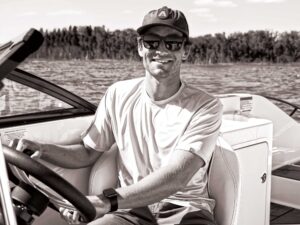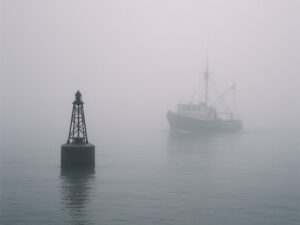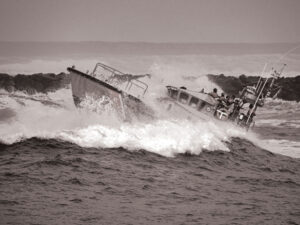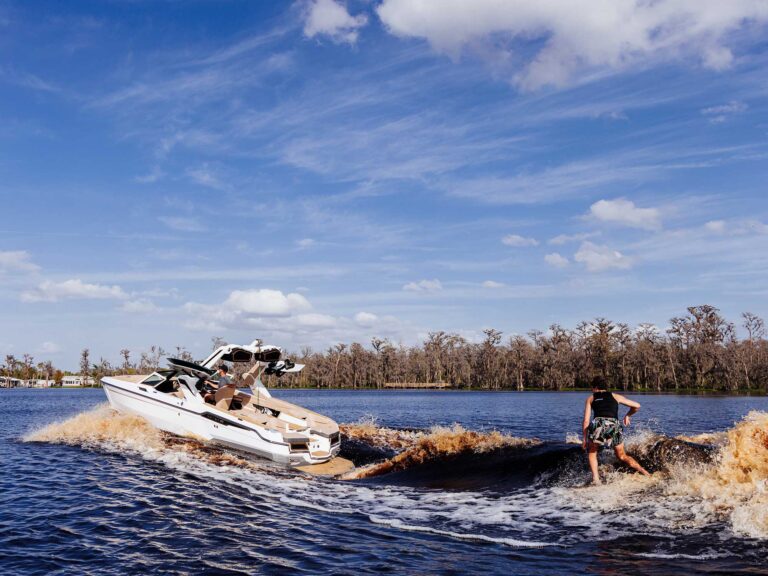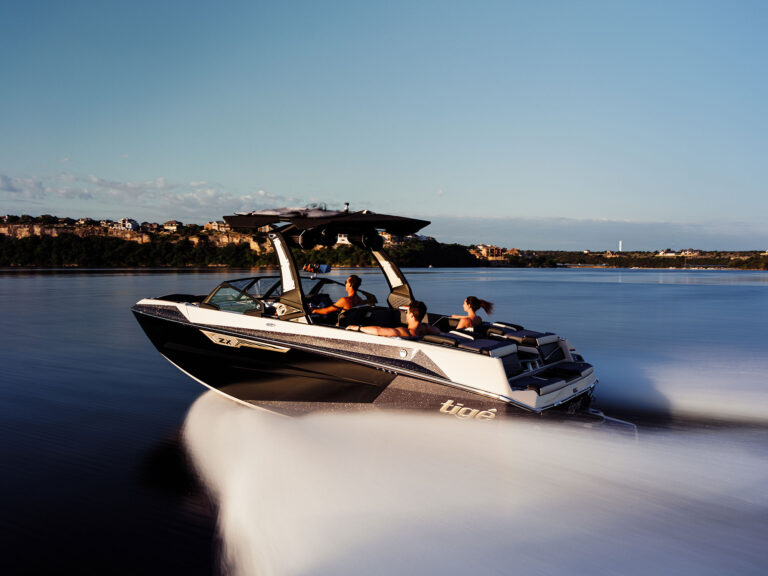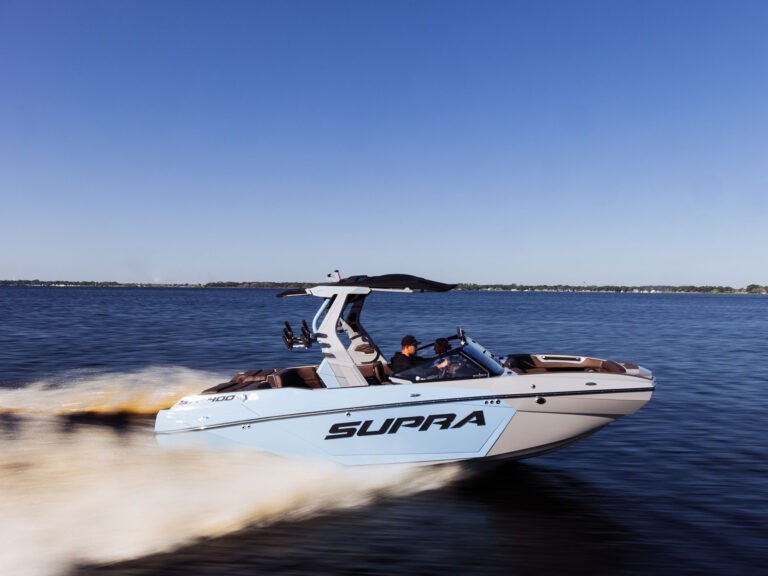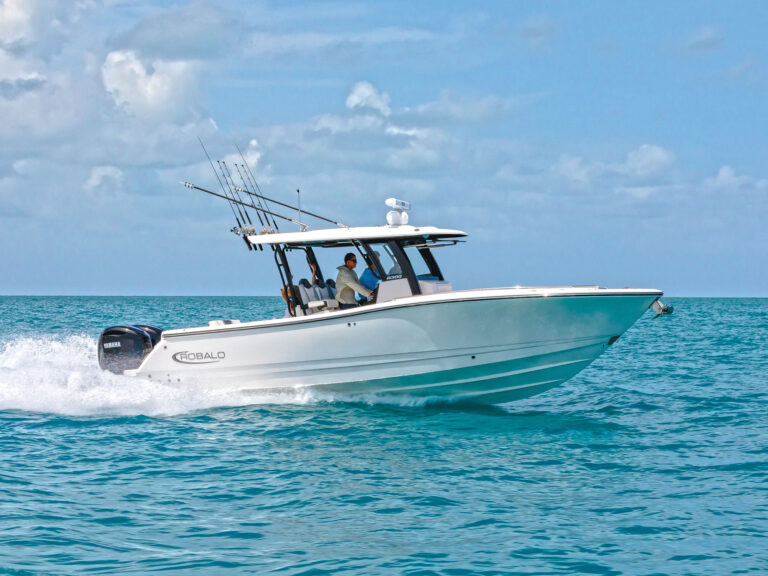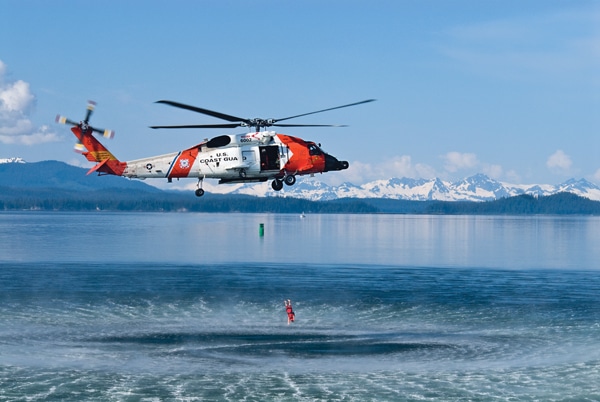
5 Minute Rule
Everybody in Alaska knows somebody who died in a boating accident. In one year, Alaskan Mike Folkerts lost two friends in separate boating accidents.
“First, I got mad,” said Folkerts. “Then, eventually I decided to do something about it.” Folkerts, at various times a bush pilot, hunting guide and business manager, finally sold his plane and bought a diesel-powered Bayliner motor yacht.
“Whenever we went out, it seemed like we were helping people out of trouble,” said Folkerts. “It’s what Alaskans do.”
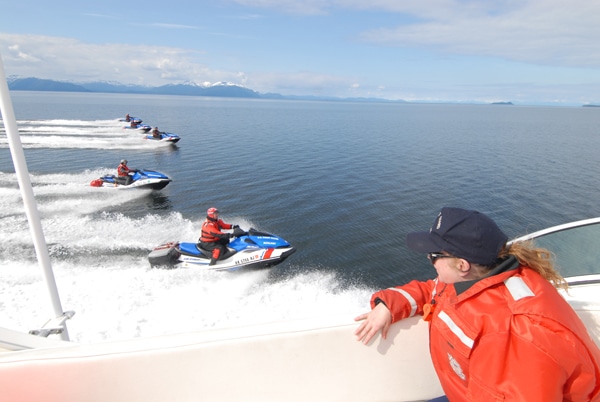
5 Minute Rule
The Coast Guard and Auxiliary noticed Mike and his wife Noreen were often the first good Samaritans on scene to lend a hand. When the Auxiliary invited them to join up, Mike and Noreen accepted.
Folkerts added Kawasaki Jet Skis to his personal Auxiliary flotilla — they coincidentally came in the Coast Guard colors. They’ve gotten mixed reviews from the Coasties.
“Some don’t see the Jet Ski as a viable rescue vehicle,” Folkerts said. But because they’re fast, maneuverable and easy to launch, Folkerts was even more frequently and more quickly in a place to lend a hand.
“One night, two guys fell asleep at their helms and ran aground at the same time,” said Folkerts.
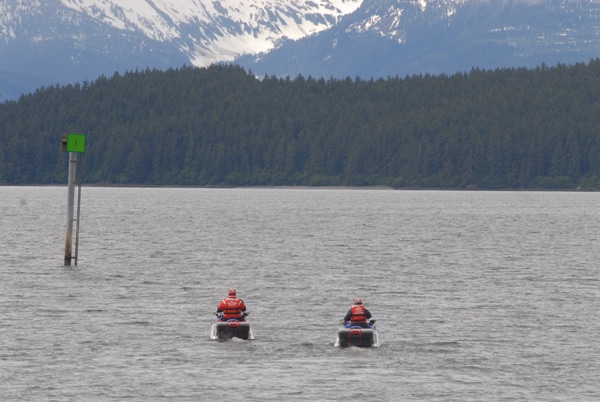
5 Minute Rule
In many waters, that’s an inconvenience, not a disaster. But walk down the steeply inclined 50-yard aluminum ramps to the floating docks and look up. The docks drop as much as 25 feet on a falling tide, sliding up and down pilings that tower overhead. If a boat hits a submerged rock and gets stuck on it, as the tide falls out from under it, it can topple down like a loose stone. That was the threat to these drowsy captains and their crews.
“I zipped back and forth between the two of them most of the night checking to see if the boats looked sound and watertight, keeping the Coast Guard informed. Both boats got off the rocks fine when the tide came up later,” Folkerts recalled.
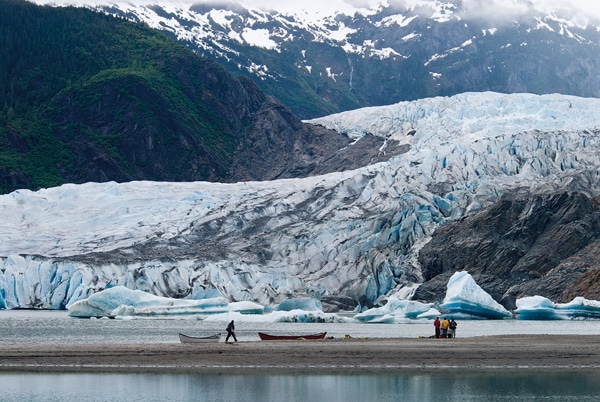
5 Minute Rule
Throughout Alaska — and North America too — most boating accidents end that way. Egos are bruised, boats are scratched and propellers dinged. Even so, in Alaska, a higher proportion of accidents end badly. Boating in Alaska claimed 12 lives in 2008. That’s nearly two per 100,000 citizens and about one per every 4,000 registered boats.
“That’s about five times the fatality rate of other states,” said Folkerts.
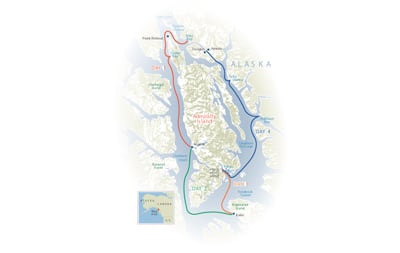
Alaskan officials are at a loss to pinpoint any one cause and admit it might be many causes. Cold water reduces the time a person can survive in the water and reduces the time one can self-rescue. The effects of cold-water immersion in water 50 degrees and under are the killer, more so than hypothermia.
“People like to say all a life jacket does is make it easier to find the body in a search and rescue,” said Coast Guard Auxiliarist Maria Mattson. Maria is a bookkeeper by trade.
“What it really does is give you about an hour and a half to be rescued,” added her husband, Bob, an Alaska Department of Environmental Conservation employee and Auxiliary volunteer.
“Hypothermia takes at least an hour to kill you in 50-degree water,” Folkerts said. “But the cold shock can rob you of coordinated movement and even coherent thought in as little as five minutes. Then, it becomes impossible to keep your airway clear of the water. That’s what kills most boaters in Alaska’s waters. Even if you have a life jacket in hand, if you have to burn energy to fasten it to your body, your chances for rescue go way down.”
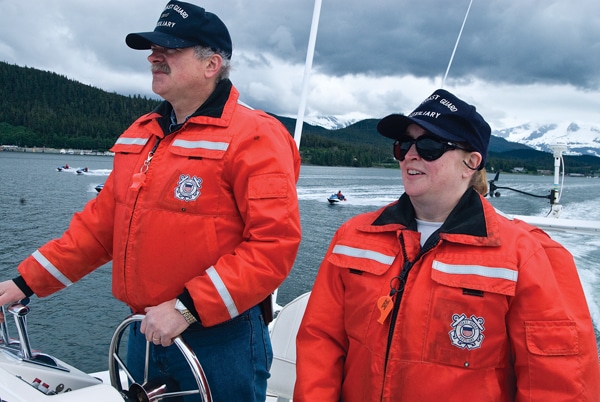
5 Minute Rule
In 2005, Folkerts was elected to be the Commodore for the United States Coast Guard Auxiliary in Alaska. Officially, he’s the Coast Guard Recreational Boating Safety Specialist for Alaska.
“I was like a kid in a candy store when they offered me that job,” he said. It was something Folkerts could grab hold of to work out the anger he still felt over losing his two friends a decade before. That loss, and the prospect of convincing Alaskans to use life jackets to buy more than five minutes of rescue time, motivated the Auxiliary Commodore in June 2008 to embark on a circumnavigation of Admiralty Island with a Coast Guard-sponsored mission: Travel 350 nautical miles to two small Tlingit Indian fishing communities seldom visited by outsiders and teach the kids how to be safe around the water.
Folkerts’ flotilla disembarked on the Noreen Kay and five personal watercraft from Auke Bay Marina in Juneau, Alaska, on a 48-degree morning. The first stop at 60 miles was Angoon, a village of about 400 on the west side of Admiralty Island. Seaplanes and boats are the only ways in or out of the town. Anyplace anyone would visit along this Island on Alaska’s famous Inside Passage is either a historic Tlingit village or the site of a 19th-century fish cannery. Angoon was both.
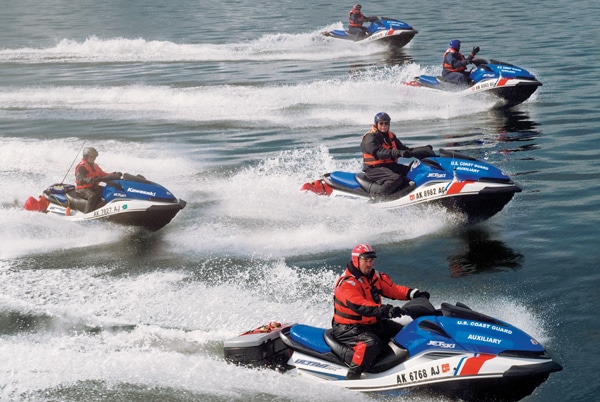
5 Minute Rule
Folkerts and his crew on Jet Skis and the Noreen Kay, captained by Bob and Marie Mattson, skirted the town and tucked up behind adjacent Killisnoo Island, the site of a once-bustling fishing town. The plan was to camp on the bear-infested Admiralty side of the pass, a prospect most of the crew found sobering at least. But they spotted Whalers Cove, a sport-fishing camp specializing in salmon and halibut fishing, and the owners lured them in with unbeatable room rates, hot showers and a meal plan. A white-coated chef waved from the deck behind the kitchen. Folkerts’ crew would eat well that night. The bears would not.
The summer’s longest day would dawn in just 48 hours, so semidarkness fell for just 40 minutes on either side of 2:30 a.m. It was the sound of Dolly Varden, a species of trout, snapping up minnows, not the sunrise that woke Lisa Ragone, a Coast Guard regular who enlisted in the Auxiliary — and this mission — for fun.
“I joined up to meet people, get better at boating and maybe do a little good,” Lt. Cmdr. Ragone said.
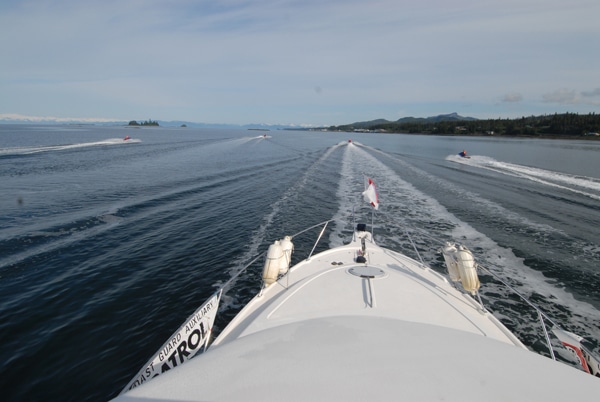
5 Minute Rule
It was the rattle of her tackle box that woke others to the prospect of fresh fish. A teapot boiled in the Noreen Kay’s galley, but just as it whistled, the chef hailed them from the lodge.
“Breakfast comes with dinner,” he said, and rods were quickly swapped for coffee mugs. In the dining room, an extravagant, steaming breakfast buffet was served and nearby was another buffet for packing box lunches.
“Lunch comes with the breakfast,” said one of the chipper hostesses.
Afterward, Mattson and Folkerts turned on the Noreen Kay’s VHF radio to hail Angoon and schedule the safety seminar.
The radio crackled with conversation. A boat had just struck a whale — or the leviathan struck the boat — in Icy Straits, and she was taking on water faster than her pumps could remove it.
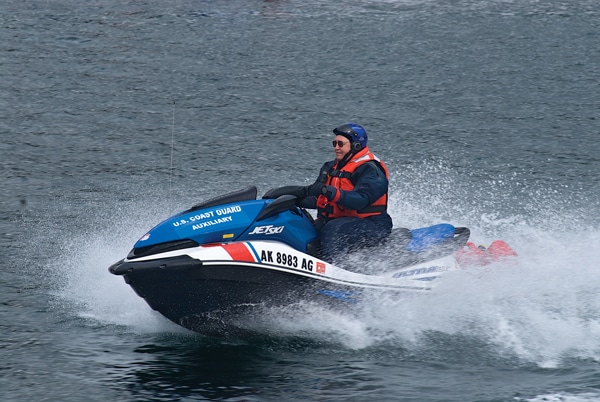
5 Minute Rule
Folkerts remembered that dozens of humpbacks had breached alongside the Noreen Kay and her Jet Skis all day yesterday; one had it in for a boater. Folkerts and Mattson unrolled a chart on the galley table to gauge the distance to the crippled boat. Coast Guard Station Sitka, about 120 miles to the Southwest was holding its chopper at the ready for a rescue. Boating Safety 101 class would be delayed while the chopper and Noreen Kay stood by.
“No single cause stands out as the reason for Alaska’s high boating death toll,” Folkerts said, not necessarily referring to the whale collision, “but the death toll is high enough to keep us very concerned.”
A commercial fisher eventually loaned the stricken vessel a spare pump, and the boat made it to port for repairs under its own power.
A humpback whale with a Moby Dick complex trumped tricky tides, treacherous reefs and fickle weather. It’s all part of the charm of Alaska’s desolate beauty. Tricky tides challenged Folkerts’ crew next, ripping out of Angoon’s inlet so fast that whitewaterlike turbulence rumpled the bay. Only the Jet Skis were nimble enough to safely approach Angoon’s seaplane dock, so Folkerts’ crew left Noreen Kay at Whalers Cove. At Angoon inlet, a red harbor buoy bobbed under the weight of four barking sea lions. Beyond them stood a white cross curiously erected on top of a nearby rock island.
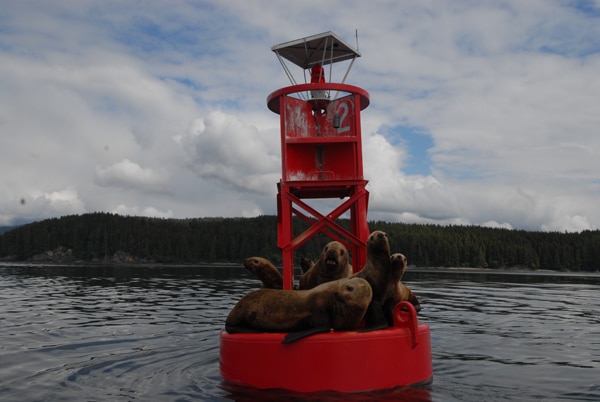
5 Minute Rule
The seaplane dock was empty, save another small monument of stacked rocks and a bundle of flowers at one corner. A few villagers ambled to the docks and a couple of men and a boy boarded a fishing boat and tinkered with the outboard, preparing to take a shot at a giant halibut that frequents these waters.
Soon, young Tlingit boys and girls wandered down the steep ramp. Noreen began yanking brand-new Stearns life jackets out of a duffle and gave them out. Stearns had donated them to assist in the mission.
The boy on the fishing boat stepped over wearing a tattered and loose-fitting life jacket that offered scant safety. The boy said nothing, but Noreen reached deep into the bag, past the brightly colored kids’ life jackets, and pulled out a man’s jacket with three secure buckles.
“That’s yours, son,” Noreen said, handing it over. The best thank-you was how quickly he buckled it on. Minutes later, the anglers shoved off into the swift current.
Soon, more than a dozen kids clustered around, eyeing the colorful life jackets. Maybe it was the bright colors or the prospect of becoming the owner of something brand new, not handed down, that sparked their eagerness, but unlike the spoiled resistance of warm-water teenage boaters from the lower 48 states, these kids couldn’t wait to get into new life jackets.
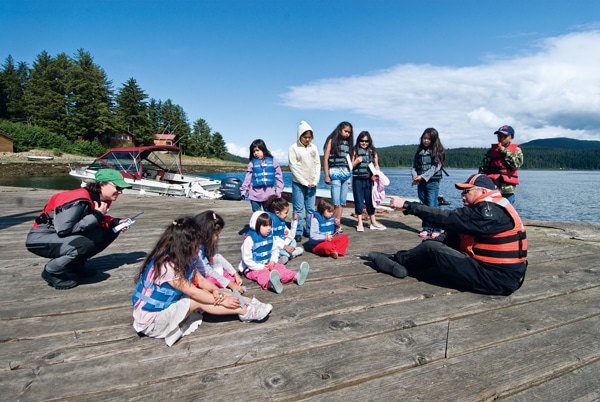
5 Minute Rule
Ask any Alaskan if they know someone who died in a boat accident, and you’ll likely get a reaction. Angoon resident Sugar (“Just Sugar,” she said) eyed a neighbor at the question and raised her closed hand. She popped up fingers, counting.
“One, two, three,” she hesitated looking at the neighbor for affirmation “four….”
Then she pointed to the stone stack monument at the corner of the dock “…five.”
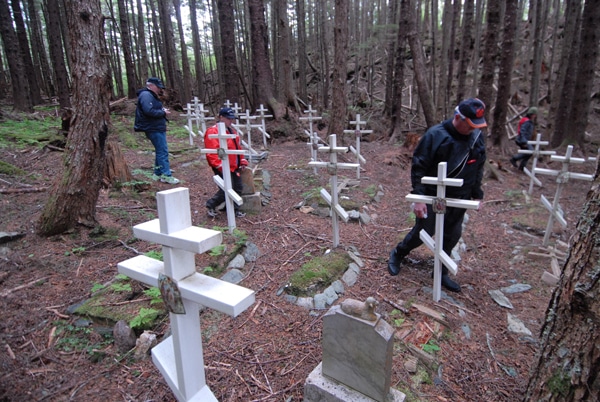
5 Minute Rule
A beloved neighbor, teacher and coach had disappeared one evening after boarding a boat. Hours of searching turned up debris from his rig but not him. Some thought he was jarred from his fishing boat when it drifted or motored against a navigation marker or piling. The tide would have taken him out.
“It was the third time he’d fallen out of his boat over the years,” Sugar said. “Did you see that white cross out on Kenasnow Rock?” She waved in the direction of the cross near the seals.
“Four people died there. Their boat overturned in sight of the town but nobody could get to them in time.”
The “Five-Minute Rule” again.
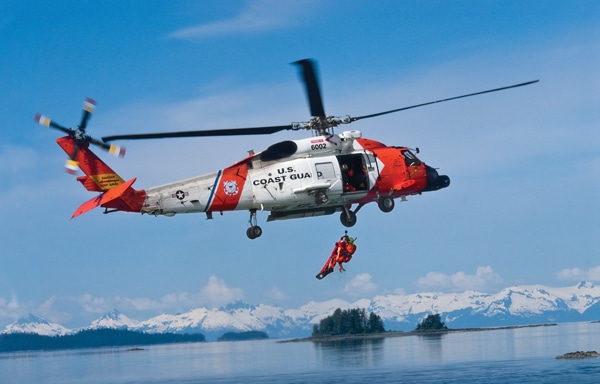
5 Minute Rule
The thuk, thuk, thuk of a Sitka Coast Guard chopper broke the quiet, and soon it swooped in from overland. At least a dozen more kids ran down the ramp, chasing the action and happily snagging life jackets, rescue whistles and signal mirrors.
The chopper hovered 150 yards from the dock, out of the tidal stream still ripping seaward past Angoon. The door slid open, and a rescue swimmer tossed out the Coasties’ version of a crash-test dummy. The rotor wash pushed the dummy away from the chopper, and then a rescue swimmer appeared in the door, waved and jumped. In a minute or less, the swimmer retrieved the dummy and both were hoisted back to the orange and white chopper before flying away. It was a five-minute demo that would make anyone happy to be a U.S. taxpayer.
“You want to be rescued?” Folkerts called to Auxiliary crewman Dan Logan, one of the Jet Ski captains. The kids all retreated in protesting squeals thinking they were about to be dunked. Logan double-checked his life jacket and the watertight zippers of his drysuit.
“Sure,” he said, not so enthusiastically and slid into the water carefully, keeping his head dry. The tide was slack now, and he paddled an easy baseball toss away.
“What would happen if you jumped in to rescue Mr. Logan?” Folkerts asked his silent students. “You’d get yourself in just as much trouble as the victim, wouldn’t you?”
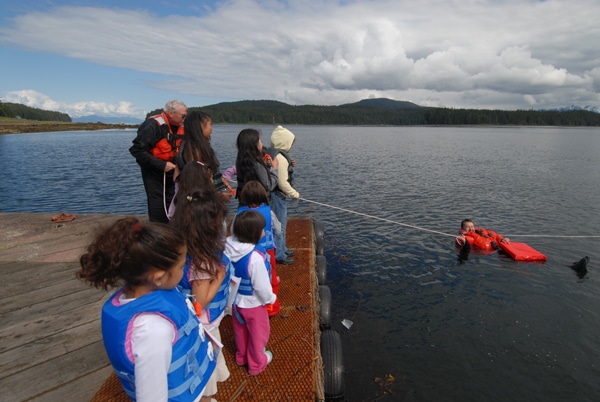
5 Minute Rule
The kids all nodded and Folkerts crooked his finger at one young girl.
“You want to rescue him? I’ll show you how.” And Folkerts handed her a throwable life jacket with a rope attached.
With surprising accuracy, she threw the float to him and then all the kids grabbed the line and tugged him in. The practice was repeated over and over again.
(Only a few weeks after the mission, two boys capsized their canoe several yards from the dock. One wore a life jacket and the other without one clung to him, while rescuers pulled the boys safely ashore.)
Kake, Alaska, was the next fishing village on Folkerts’ mission route. It took an entire unusually sunny afternoon to travel 150 nautical miles and make port around 7 p.m. The sun shone down like 2 p.m. in Iowa. Steering clear of a departing ferry, the Jet Skis ran in ahead of the Noreen Kay to scout out the fuel dock and arrange berths. Ashore, Folkerts called an impromptu meeting to recap the day and streamline the safety-school procedures.
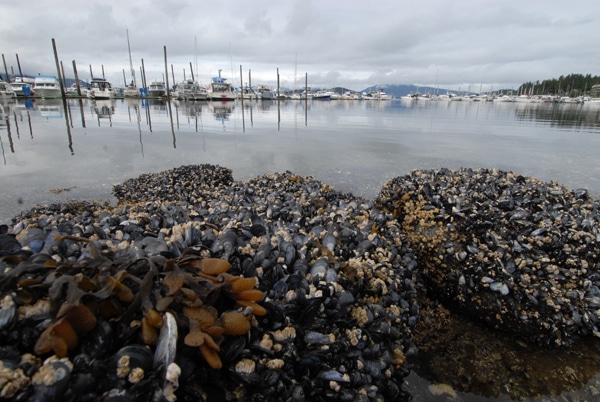
5 Minute Rule
The next morning, at Kake’s seaplane dock, two boys leaned far over the 20-foot-high ferry dock nearby, teasing Dolly Varden with fishing lines. I watched them at a distance and called them softly. Any surprise could result in a misstep and possible tragedy. It was far more than a five-minute swim to shore from beneath the end of the ferry dock.
“Why don’t you boys walk down to the seaplane dock? They’ll give you life jackets so your mom won’t worry so much,” I said. Silently, they scampered down the ramp to the Auxiliary crew. Minutes later, vests buckled firmly in place, they returned to angling.
At least 30 kids and their parents scurried down to the dock for free life jackets, rescue whistles and rescue training. After the Coast Guard chopper left, Dan Logan agreed again to be hauled in by any kid with arm enough to sling a PFD across the chilly water.
With the last mission stop behind them, Folkerts’ crew headed toward Pybus Bay, where they’d reserved frail and rustic wilderness cabins. The discussion of bears came up once again.
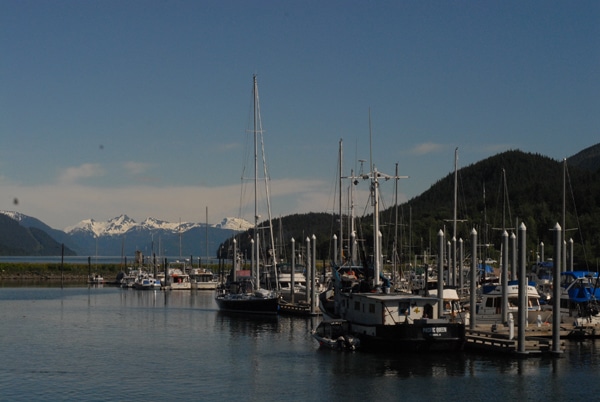
5 Minute Rule
Mark Powers of Whalers Cove had asked Mike Folkerts to deliver a message to the owner of Pybus Point Lodge, so the Noreen Kay and other Jet Skis drifted offshore waiting for Folkerts to make his delivery. A short distance beyond the lodge, across the deep bay, a 175-foot yacht was at anchor. Lodge owner Alan Veys ran to greet Folkerts, who rode in on a Jet Ski. After a few moments of discussion, Folkerts zipped back out to the Noreen Kay.
“He insists we join him at the lodge tonight,” Folkerts said in a tone that said he was touched by the generosity. “He says he has dinner guests from only that yacht out there, and since the chef is cooking, he’d like a full table.”
The bears would go hungry again as we slept in comfort and showered with hot water.
The hospitality of Alaskans is often the only buffer against Alaska’s sometimes inviting, often inhospitable and incredible wilderness beauty. The Auxiliary mission, like most Alaskans and Alaskan visitors, was glad to accept the risk, and though in return they gave only free advice and a box of life jackets, both offered the ultimate gift: an extra chance at life in a tight spot, and a way to beat the Five-Minute Rule.

